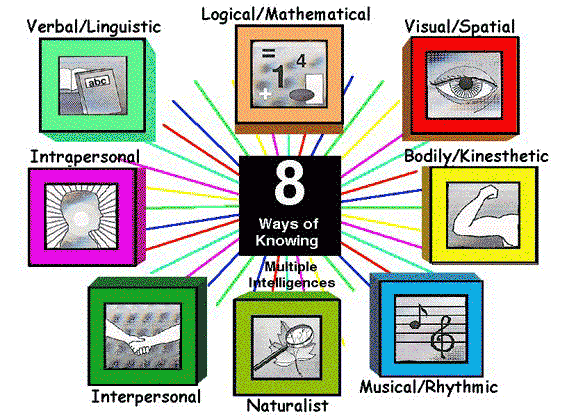| ESE504 : The Class : Advanced CD : Reading Response | |||||
 Assignment
Two: Applications
Assignment
Two: Applications
There are several layers of knowledge that contribute to a seemingly natural ability to recognize student needs. The PEPSI model focuses attention on the puzzle pieces. We sort through the behaviors that are typical for a child of - say seven - and then look to see if the behaviors the child is manifesting are pretty typical or not what might be expected.
We cannot just look at the way a student is behaving (symptoms) to give us a complete picture. There is an array of pieces that fits together in different ways for different children. Some children have the personality to really make age seven painful for themselves and others. Remember, many people refer to age seven as life in a minor key. So - it is easy for a parent or teacher to look at the whining, loss of volition, attention seeking, lack of focus and self absorption in a child and feel that something is wrong. In fact, many people diagnose children with attention deficit disorder during the seventh year, because so many actions of seven year olds mirror the checklist of characteristics for ADHD.
 SO! As nice as it might be to believe that what we see is what we get,
we cannot count on taking a list of observable behaviors and brewing up
a perfect, 'one size fits all' recipe for learning success.
SO! As nice as it might be to believe that what we see is what we get,
we cannot count on taking a list of observable behaviors and brewing up
a perfect, 'one size fits all' recipe for learning success.
Another important consideration involves just how much of a child we need to know about. Some programs place most of the attention on cognitive development. This makes a lot of sense, because our reporting systems support this. Our testing programs are geared to finding the academic achievement of youngsters, particularly with respect to literacy skills and math. Our report cards usually report a student's level of perceived ability in subjects - like Reading -English, Social Studies - History, Math - Algebra, Science - Chemistry.
With so much emphasis placed on academic subjects and so little time for all there is to know, we find a survival path. We narrow the focus to acquiring knowledge - teaching and testing facts, preparing students to pass tests, to score well, to get into higher educational opportunities. That may be a great recipe for academic success, but it doesn't prepare youth for any other kind of success.
 SO! There are many other ways of being and kinds of learning. There are
a number of factors that influence the student's ability to learn -- that
may dramatically alter a child's use of intellectual ability - and when
we work to strengthen a child's learning ability, there are things that
must be given attention if we want to give a student the best chance to
succeed.
SO! There are many other ways of being and kinds of learning. There are
a number of factors that influence the student's ability to learn -- that
may dramatically alter a child's use of intellectual ability - and when
we work to strengthen a child's learning ability, there are things that
must be given attention if we want to give a student the best chance to
succeed.
What are some of those factors?
PEPSI model
| P |
Physical Development
|
P |
| E |
Emotional Development
|
E |
| P |
Philosophical
development
|
P |
| S |
Social development
|
S |
| I |
Intellectual
development
|
I |
![]()
Learning Modalities
| Visual | Seeing something, visualizing it | pictures,maps, reading movies, charts, |
| Aural | Hearing something, talking it over with someone, saying things out loud for verification, teaching | Telling or hearing stories, cooperative learning in groups, chatting, music |
| Kinesthetic/ Perceptual | Moving to learn, rhythm, chanting, hands-on, color, odor | moving about while learning, role playing, puppet work manipulatives, electroboards, computer work |
| Tests | ||
| Links |
![]()
David Lazear's Eight Intelligences
|
Click here to go to the web site about these
intelligences
 |
![]() Social
and Cultural Influences
Social
and Cultural Influences
Family and School
|
|
![]()
 |
Genetic Predisposition and Personality
|
![]()
 WOW!
There are so many things to take into consideration. Where do we begin?
WOW!
There are so many things to take into consideration. Where do we begin?
A. OBSERVING
1. Observing the student is critical. Sometimes we need help to focus our observations. We look around and observe all the time, but sometimes we don't "SEE."
* Define what you are looking for
* Set aside several times and really look, pointedly, for those things you defined
* Keep a record of what you are looking for and compare results from previous observation sessions
2. Thinking about our thinking is another important step in honing observation skills. Discuss what you see and how you are thinking about it with others.
3. Reading about the behaviors and the different ways authors describe the human experience also shifts and deepens observation skills.
4. Making video footage and reviewing what you saw and what you missed can also enhance your skills.
B. SOCIAL HISTORY
1. Talk with students about their feelings, how they see themselves, how they see their world, what they believe others think of them.
2. Scrutinize the school records to see how the student has progressed and how others view the student.
3. Walk through different assignments with the student and have them tell you about what they do and why -- how they think of the subject, how they approach solving it, what their internal dialogue is about the things they can do well and the things that are challenging.
4. Set aside time to talk with the parents.
* When possible, do it in the home to get a sense of the family dynamics and the student's cultural richness.
* Spend some of the time in free conversation - and that may work best as part of an interview or after the ice is broken by taking a social history.
* Be open to family pictorial histories and family anecdotes about the child and the family memory of who the child is, what the child excels at, when the child is asked to contribute to the family and what is asked.
5. Use informal tests to ascertain learning styles, ways of approaching problems, social skills and interactions.
6. Remember to acquire and catalogue information and to stay away from "labeling," valuing or devaluing a person's life or way of learning and thinking.
C. THE WHOLE CHILD
1. Look at the physical, emotional, philosophical, social and intellectual components of the child. Look for ways they interact, the process the student uses to make up for deficits or weak points, how the student describes self and how the student communicates sense of being.
2. When a child is pushing for autonomy, the PEPSI model looks different than when the student is pushing for acceptance or is more heteronomous. Factor in the pressure coming from the need to express self and how that blend with the need for acceptance.
3. Gain insight about the student's self esteem. Watch specifically for the blend of need to do and the willingness of the child to be.
4. Factor in the source of most valued esteem messages - or who the student views as the referent. Does the student react most to positive or negative message from - parents, peers, teacher -- mother, dad, siblings, friends, those outside the circle of friends, gang members.
5. What is the dominant world view for the child -- is there evidence that he or she feels safe, capable, accepted, optimistic about the self and the future, or are the verbal and nonverbal messages a clue to feeling unsafe, lacking in ability, unwanted, unhappy, uncertain the future, misplaced and misunderstood?
 |
Polly says: If you are a new teacher, this may be too much, all at once. In the first two or three years, give yourself time to get the basics, and later add individualization skills and support differing learning styles. It's like any other art or skill -- like bike riding. First get good at riding without falling, then get the bike going fast and it is then that you can jump curbs, do wheelies and ride with no hands. |
![]()
Reading Response
:Matching Developmental Levels to Promote Learning
and Success
- Using one of the PEPSI profiles you developed on a student, review the concepts of conducting a PEPSI screening to determine student level of development in the areas of physical, emotional, philosophical, social and intellectual development.
- Establish a sense of history with respect to the child and family, getting a feel for what conditions promote growth, and gaining a sense of life flow. From that perspective, write a one year, five year and ten year wish list for the youth.
- Now go back and revisit the strengths and growth needs for the student PEPSI profile.
- Using the PEPSI screening profile, wand wish list, develop a series of IEP objectives for the student. Remember to balance strengths and weaknesses so the student's abilities are highlighted.
Rubric
Excellent A PEPSI of a child is
presented that shows consistency of thought, substantiates points in a
systematic manner, provides examples to back up decisions on developmental
levels. Strengths and growth needs are listed and appear to "follow"
from the PEPSI profile. The objectives are balanced, providing an opportunity
for the child to feel a sense of hope about self, and gives parents the
sense that the development of the IEP is a process that builds and supports
a child's strengths and supports skill and personal development as a nurturing,
positive and natural function of the child's abilities and goals.
Good A PEPSI of a child is presented.
Strengths and growth needs are listed and the objectives are balanced,
providing evidence that some awareness of students strengths as well as
weaknesses are being addressed as part of the long term goals.
Marginal A PEPSI of the child is presented without providing justification
for developmental position. The IEP objects lack consistency or seem hastily
gathered and perfunctory. The IEP process appears to meet the letter rather
than the spirit of the mandate, with little recognition of the student
as a person or the critical need of parents to feel that the child's best
interests are a critical factor in the process.
|
Questions ? |
 |
This is an optional assignment. You may wish to read these questions and let them "simmer" as part of the philosophical development process for yourself. You may also wish to discuss these ideas at WebCT or go to a teacher chat room and interact with others, finding out what others in the field believe. [50 pts]
Part A
![]() How can a teacher blend content and the needs of the individual child?
How can a teacher blend content and the needs of the individual child?
![]() How can a teacher give individualized time and attention to each child?
How can a teacher give individualized time and attention to each child?
![]() Should we expect a teacher to have the skills to synthesize these disparate
functions?
Should we expect a teacher to have the skills to synthesize these disparate
functions?
![]() If education ignores the mandate to facilitate development of a child
emotionally, socially, philosophically, is there someone who will provide
meaningful growth experiences?
If education ignores the mandate to facilitate development of a child
emotionally, socially, philosophically, is there someone who will provide
meaningful growth experiences?
Part B
![]() Is holistic development an example of a parent right and responsibility?
Is holistic development an example of a parent right and responsibility?
![]() Do teachers bear any responsibility or have any rights with respect to
helping a child mature?
Do teachers bear any responsibility or have any rights with respect to
helping a child mature?
![]() Is this an individual vs. society issue?
Is this an individual vs. society issue?
![]() If all areas but intellect belong to the family, what would the curriculum
look like?
If all areas but intellect belong to the family, what would the curriculum
look like?
![]() Is it possible that developing the whole child might provide students
with a sense of ownership in learning and thus actually enhance scores?
Is it possible that developing the whole child might provide students
with a sense of ownership in learning and thus actually enhance scores?
Part C
![]() We are testing intellectual progress and reporting that to the nation.
Is that because we have no right to other domains? Is it because we don't
know how to test other areas of development?
We are testing intellectual progress and reporting that to the nation.
Is that because we have no right to other domains? Is it because we don't
know how to test other areas of development?
![]() Do report cards address areas of development other than cognitive? If
not, how might we reflect our work with other areas of the child?
Do report cards address areas of development other than cognitive? If
not, how might we reflect our work with other areas of the child?
![]() How might we integrate a more holistic child focus without giving less
emphasis to cognition?
How might we integrate a more holistic child focus without giving less
emphasis to cognition?
![]() If we focus on community building and reporting success or failure
in this arena, will we find that we are already presenting this material,
but not systematically?
If we focus on community building and reporting success or failure
in this arena, will we find that we are already presenting this material,
but not systematically?
![]() How should be be measuring process skills? Will a portfolio approach do
it?
How should be be measuring process skills? Will a portfolio approach do
it?
![]() Must all assessment be gleaned from observable, quantifiable data? Is
our reliance on the scientific method part of the reason we are having
difficulty measuring in other ways?
Must all assessment be gleaned from observable, quantifiable data? Is
our reliance on the scientific method part of the reason we are having
difficulty measuring in other ways?
Rubric
Excellent Lists and addresses
the pros and cons, shows evidence of critical thinking -- analysis, synthesis,
evaluation with consistency of thought is present, substantiates points
in a systematic manner in the summary paragraph, addresses parts a, b,
and c in a cogent and thoughtful manner; may provide examples to back
up points.
Good Addresses the questions and is consistent
with expression of beliefs; shows consistency across most items, provides
some justification for beliefs or identifies some of the experts and the
vocabulary consistent with the point of view shows some evidence of reflective
thinking by utilizing analysis, and may have the appearance of emerging
thinking about ways that education and development impact each other.
Marginal States a position without providing justification or rational
argument; ideas lack consistency or seem hastily gathered and presented.
The student will receive assistance in sharpening the essay.